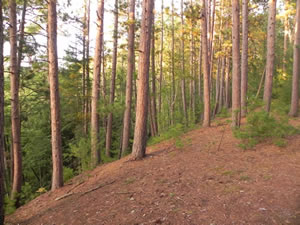Warming Climate Has Consequences for Michigan's Forests

In the last 100 years, Michigan has become warmer, with more rain coming through heavy downpours. Climate models suggest that the state will continue to warm and variability in precipitation patterns will increase, which will have consequences for the state’s forests. A new U.S. Forest Service report describes the potential risks and opportunities of climate change for forests in the eastern Upper Peninsula and northern Lower Peninsula.
More than 30 scientists and forest managers contributed to “Michigan Forest Ecosystem Vulnerability Assessment and Synthesis.” The study is part of the Northwoods Climate Change Response Framework, a collaboration of federal, state, academic and private partners led by the Forest Service’s Northern Institute of Applied Climate Science (NIACS). The report was published by the U.S. Forest Service’s Northern Research Station and is available online at: http://www.nrs.fs.fed.us/pubs/45688.
“Climate change information is often presented at scales that are hard to digest,” said Stephen Handler, the lead author for the vulnerability assessment. “This report is designed to give forest managers in Michigan the best possible science on effects of climate change for our particular forest ecosystems, so they can make climate-informed decisions about management today.”
The assessment evaluates the vulnerability of forest ecosystems within a 16.6-million-acre area in Michigan’s eastern Upper Peninsula and northern Lower Peninsula, about 70 percent of the state’s forested land cover. Topics covered include information on the contemporary landscape, past climate trends, and a range of projected future climates.
Climate impact models project a decline in northern species such as balsam fir, black spruce, white spruce, tamarack, jack pine, northern white-cedar, and paper birch. Southern tree species near their northern range limits may fare better. Species that may become more widespread include American basswood, black cherry, green ash, white ash, and white oak. Climate change is also expected to intensify several stresses that forests already face, such as damaging insect pests and diseases, drought, and wildfire.
While climate models vary on the degree of change and the regions where it will occur, by the end of the 21st century, northern Michigan is projected to experience a climate that is hotter with more variable precipitation, more moisture stress towards the end of the growing season, and less characteristic winter weather. In addition to conditions becoming less favorable for northern forest species and conditions improving for southern species, the vulnerability assessment finds:
- Soil moisture patterns will change, with drier soil conditions later in the growing season.
- Low-diversity systems are at greater risk.
- Tree species and forest types that are better able tolerate disturbances such as wildfires, floods and pest outbreaks may be favored.
In the past 100 years, the mean annual temperature across the area studied in the vulnerability assessment increased 1.7 degrees Fahrenheit. From 1900 to 2011, mean annual precipitation increased by 4.9 inches across the assessment area and intense precipitation events became more frequent. In Michigan, there was a 180-percent increase in rainstorms of 3 inches or more between 1960 and 2011.
“Confronting the challenge of climate change presents opportunities for foresters and other decision-makers to plan ahead, manage for resilient landscapes, and ensure that the benefits that forests provide are sustained into the future,” said Michael T. Rains, Director of the Northern Research Station and the Forest Products Laboratory. “Forest Service science is delivering tools and data that will help managers in Michigan and throughout the nation meet this challenge.”
###
The Northern Institute of Applied Climate Science (NIACS) is a collaborative effort by the Forest Service, Michigan Technological University, the Trust for Public Land, and the National Council for Air and Stream Improvement to provide information on managing forests for climate change adaptation, enhanced carbon sequestration, and sustainable production of bioenergy and materials. As a regional, multi-institutional entity, NIACS builds partnerships, facilitates research, and synthesizes information to bridge the gap between carbon and climate science research and the information and management needs of land owners and managers, policymakers, and members of the public.
The mission of the U.S. Forest Service is to sustain the health, diversity, and productivity of the nation’s forests and grasslands to meet the needs of present and future generations. The agency has either a direct or indirect role in stewardship of about 80 percent of our nation’s forests, amounting to 850 million acres including 100 million acres of urban forests gracing the nation’s cities, where 80 percent of Americans live. The mission of the Forest Service’s Northern Research Station is to improve people’s lives and help sustain the natural resources in the Northeast and Midwest through leading-edge science and effective information delivery.
Media Contact
More Information:
http://www.nrs.fs.fed.us/news/release/Mi-EVASAll latest news from the category: Agricultural and Forestry Science
Newest articles

Silicon Carbide Innovation Alliance to drive industrial-scale semiconductor work
Known for its ability to withstand extreme environments and high voltages, silicon carbide (SiC) is a semiconducting material made up of silicon and carbon atoms arranged into crystals that is…

New SPECT/CT technique shows impressive biomarker identification
…offers increased access for prostate cancer patients. A novel SPECT/CT acquisition method can accurately detect radiopharmaceutical biodistribution in a convenient manner for prostate cancer patients, opening the door for more…

How 3D printers can give robots a soft touch
Soft skin coverings and touch sensors have emerged as a promising feature for robots that are both safer and more intuitive for human interaction, but they are expensive and difficult…





















